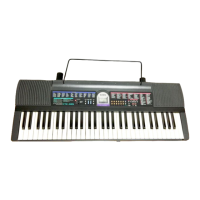— 1 —
SPECIFICATIONS
GENERAL
Model: CTK-485
Keyboard: 61 standard-size keys, 5 octaves
Tones: 100
Polyphony: 12 notes maximum (6 for certain tones)
Auto accompaniment
Rhythm Patterns: 100
Tempo: Variable (236 steps, = 20 to 255)
Chords: 2 fingering methods (CASIO CHORD, FINGERED)
Rhythm controller: START/STOP, SYNCHRO/FILL-IN
Song Bank
Tunes: 100
Controllers: PLAY/PAUSE, STOP, LEFT (ON/OFF), RIGHT (ON/OFF)
Multi function display
Name display: TONE, RHYTHM, SONG BANK name/number, keyboard settings name/
value
Tempo: Tempo value, metronome, synchro standby, beat indicator
Other functions
Transpose: 12 steps (–6 semitones to +5 semitones)
Tuning: Variable (A4 = approximately 440 Hz ± 50 cents)
Volume: 0 to 9 (10 steps)
Terminals
Phones/output terminal: Stereo standard jack
Output Impedance: 70 Ω
Output Voltage: 2.4 V (RMS) MAX
Power supply terminal: 9 V DC
Power supply: Dual power supply system
Batteries: 6 AA-size batteries
Battery life: Approximately 2 hours (SUM-3/R6P)/4 hours (AM3/LR6)
AC adaptor: AD-5
Auto power off: Turns power off approximately 6 minutes after last key operation. Enabled
under battery power only, can be disabled manually.
Speaker output: 2.0 W + 2.0 W
Power consumption: 9 V .
.
. 7.0 W
Dimensions (HWD): 91.0 × 32.2 × 9.0 cm (35 7/8 × 12 11/16 × 3 9/16 inches)
Weight: Approximately 4.0 kg (8.8 lbs) (without batteries)
CONTENTS
Page
Specifications ............................................................................................................................................ 1
Block Diagram........................................................................................................................................... 3
Circuit Description ..................................................................................................................................... 4
Troubleshooting ........................................................................................................................................ 8
Adjustment ................................................................................................................................................ 9
Major Waveforms .................................................................................................................................... 10
Printed Circuit Boards ............................................................................................................................. 11
Schematic Diagrams ............................................................................................................................... 13
Exploded View ........................................................................................................................................ 16
Parts List ................................................................................................................................................. 17

